Oxnard Cuts Water Rates for Businesses : Economy: City also slashes traffic fees in an effort to draw new industry. Official cites the loss of jobs in recent years.
- Share via
The city of Oxnard rolled out the welcome mat for new business Tuesday, cutting water rates for large customers and slashing traffic fees in half in an effort to attract new industry to the city.
Taken together, the fee reductions will result in substantial savings to businesses interested in moving to Oxnard, said Steven Kinney, the city’s economic development director.
“We’ve lost a lot of jobs in the last several years, and we need to make them up,” Kinney told City Council members. “This is really a stimulus program. It’s not just a break for developers.”
While the reduction in traffic fees will only benefit new development, the lower water rates will result in a windfall to the largest businesses in Oxnard.
Under the new schedule, homeowners will continue to pay escalating rates for greater water consumption. But apartment buildings, businesses and industry will now pay lower rates the more water they use.
Procter & Gamble--the city’s largest water user--will benefit most, saving $430,000 a year.
Savings will average about $9,000 a year for the 10 apartment buildings with the highest water use, about $32,000 annually for the 10 businesses with the heaviest water usage and about $70,800 annually for the 10 manufacturers that use the most water.
The council unanimously approved a reduction in traffic fees for new development from $348 per trip to just under $174. Under the new rate, a typical industrial company opening a 10,000-square-foot building will save about $10,400.
To cut the fees by half, city staff identified $212 million in traffic improvements that can either be delayed or paid for from as-yet unidentified sources. Among the projects that will need alternative funding are new interchanges for the Ventura Freeway at Rice and Rose avenues, and a new freeway bridge over the Santa Clara River.
The loss of revenues troubled Councilman Tom Holden.
“Everybody knows these improvements are vital,” Holden said. “What’s going to happen down the road if we have 50% lower traffic fees, but are not able to make the improvements because no new funding source is found?”
City Manager Tom Frutchey countered, saying the lower fees would help attract new businesses that, in turn, would generate property and sales taxes to help pay for the improvements.
Councilman Michael Plisky said high fees have hurt Oxnard’s ability to attract new businesses.
“We’ve choked off business to the point where we don’t have another choice” but to reduce fees, he said.
The move to reduce traffic fees was supported by representatives from the Building Industry Assn. and the National Assn. of Industrial Parks.
The City Council also approved adjustments to the city’s utility rates for trash, sewer and water as part of a broad study of how to deliver utilities more efficiently.
Under the changes approved unanimously by the council, the rates that a typical homeowner will pay for each utility will drop slightly beginning Jan. 25. Sewer rates will fall 1.4%, water rates 0.5% and trash rates 0.9%.
The total monthly bill for all three utilities for a typical homeowner will fall to $61.14 from the current $61.71.
Overall, water rates will drop by 14.6%, but almost all of that will be realized by the city’s largest water customers.
Water rates are scheduled to fall by 36% for the largest apartment houses, between 21% and 45% for large businesses, and 35% for large manufacturers.
The rates will remain nearly the same for typical single-family homes, with the total monthly bill declining nine cents to $19.82. The adopted rate for small water users was lower than the city first announced last week, when single-family homes were expected to pay 23 cents more a month.
But rates will rise 17% for high-use homeowners, 20% for small apartment buildings, and between 36% and 141% for small businesses. That translates to monthly increases of nearly $10 for homeowners who are heavy water users, $2 for small apartment buildings, and between $4 and $7 for small businesses.
The change was criticized by perennial council candidate Roy Lockwood.
“Before we had a case where industry was subsidizing homeowners,” Lockwood said. “As now proposed, residences will be subsidizing industry.”
More to Read
Sign up for Essential California
The most important California stories and recommendations in your inbox every morning.
You may occasionally receive promotional content from the Los Angeles Times.










